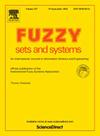The characterization of monotone functions that generate associative functions
IF 3.2
1区 数学
Q2 COMPUTER SCIENCE, THEORY & METHODS
引用次数: 0
Abstract
Consider a two-place function defined by where is an associative function, is a monotone function that satisfies either when or for any when for all and is a pseudo-inverse of f. In this article, the associativity of the function T is shown to depend only on properties of the range of f. The necessary and sufficient conditions for the T being associative are presented by applying the properties of the monotone function f.
生成关联函数的单调函数的表征
考虑由 T(x,y)=f(-1)(F(f(x),f(y))定义的双位函数 T:[0,1]2→[0,1],其中 F:[0,∞]2→[0,∞]是关联函数,f:[0,1]→[0,∞]是一个单调函数,当 f(x+)∈Ran(f) 时,满足 f(x)=f(x+) 或当 f(x+)∉Ran(f) 时,对于所有 x∈[0,1],对于任意 y≠x,满足 f(x)≠f(y);f(-1):[0,∞]→[0,1]是 f 的伪逆。本文证明了函数 T 的关联性只取决于 f 范围的性质,并应用单调函数 f 的性质提出了函数 T 关联性的必要条件和充分条件。
本文章由计算机程序翻译,如有差异,请以英文原文为准。
求助全文
约1分钟内获得全文
求助全文
来源期刊

Fuzzy Sets and Systems
数学-计算机:理论方法
CiteScore
6.50
自引率
17.90%
发文量
321
审稿时长
6.1 months
期刊介绍:
Since its launching in 1978, the journal Fuzzy Sets and Systems has been devoted to the international advancement of the theory and application of fuzzy sets and systems. The theory of fuzzy sets now encompasses a well organized corpus of basic notions including (and not restricted to) aggregation operations, a generalized theory of relations, specific measures of information content, a calculus of fuzzy numbers. Fuzzy sets are also the cornerstone of a non-additive uncertainty theory, namely possibility theory, and of a versatile tool for both linguistic and numerical modeling: fuzzy rule-based systems. Numerous works now combine fuzzy concepts with other scientific disciplines as well as modern technologies.
In mathematics fuzzy sets have triggered new research topics in connection with category theory, topology, algebra, analysis. Fuzzy sets are also part of a recent trend in the study of generalized measures and integrals, and are combined with statistical methods. Furthermore, fuzzy sets have strong logical underpinnings in the tradition of many-valued logics.
 求助内容:
求助内容: 应助结果提醒方式:
应助结果提醒方式:


